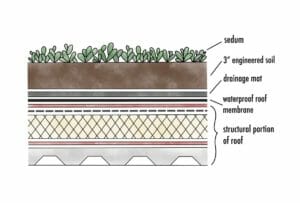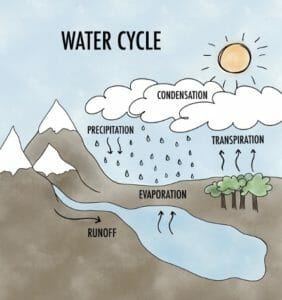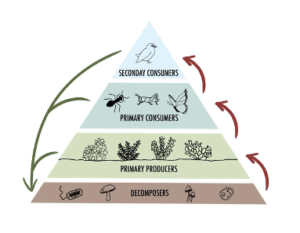Green infrastructure is a unifying theme across the UREx SRN network cities, given its potential for stormwater management along with other benefits like heat mitigation and aesthetic improvements. Green infrastructure implementation is in various stages in our networks cities, and in Syracuse UREx SRN Mentor, Cliff Davidson has worked to integrate an ecological-technological solution through the green roof on the Convention Center in downtown Syracuse.
The Syracuse Convention Center green roof is over 60,000 square feet. The roof underwent a retrofit in 2011, when the green roof was added, and an extensive network of monitoring equipment allows for a plethora of data. Some examples of the data available is rainfall, rooftop runoff, soil moisture, windspeed, temperature through each layer of the roof. Undergraduate and graduate students have utilized this data for their research on the green roof since its construction in areas such as chemistry, energy, and hydrology. The green roof is built on top of a traditionally constructed roof, with a sheet drain, 3” of engineered growth medium, and the vegetation above it. There are five different species of sedum on the roof as shown in the illustration below by UREx SRN graduate student, Courtney Gammon.Courtney was a recipient of the 2020 summer UREx graduate grant, and her current research revolves around using the software HYDRUS-1D to model flow through the OnCenter green roof. Extensive inputs for the green roof are required for modeling, many of which are available through historic and real-time datasets from the green roof’s monitoring network. Other inputs are from mathematical exploration and additional student research. UREx SRN Research Experience for Undergraduate (REU) student, Anna Wojcik’s research on Leaf Area Index will be included in the data sets for modeling. If the model is successful it can be used to predict performance of the roof in future weather events, or to examine how similar roofs with function in locations with varied climate.
Additionally, the OnCenter green roof is being used as a tool for middle school education in New York schools to combat climate change. As part of the UREx SRN REU summer program, Libby Cultra is working with Cliff Davidson and graduate student Courtney Gammon to create a lesson plan using this green roof. The lesson plan utilizes activities, stories, experiments, and figures to teach 7th through 9th graders about green infrastructure in an improved and modern way. The unit is based on the Next Generation Science Standards, which are new STEM guidelines for K-12 students. A NGSS style lesson plan includes important, core subjects (Life, Earth, Physical Science, etc.) that are necessary for science education. Each unit or lesson plan achieves learning goals and follows coded standards made specifically for NGSS. Most importantly, problem-solving and modeling, which are connected to engineering practices, are also a key part of the NGSS learning experience.
Activities and interactive stories throughout the lesson guide both teachers and students, making it easy to navigate through each lesson. Figures drawn by the Syracuse research team were made for easy comprehension by the students. Two examples are our water cycle and food pyramid diagrams (shown below).
Libby’s lesson plans, made for five 50 minute class periods, teach kids about the water cycle, carbon cycle, plant anatomy, natural hazards, ecosystems, and green roof benefits. Ecological cycles like the water and carbon cycle are amazing observable phenomena that continually occur on Earth, with plant life on a green roof playing a big role. Hands-on learning using real data will show students measurable benefits of green infrastructure. For example, the OnCenter green roof collects excess rainwater that could potentially cause flooding in cities. Students get to see the water cycle in action through live graphs of runoff, precipitation, and temperature. Data is collected every five minutes. Using this data, students will also learn about soil saturation and where water travels after it reaches the ground.
This project is currently being reviewed by New York State Master Teachers. Eventually, we hope to distribute the completed plan to schools in the area and in an online format to promote sustainability to future generations.



